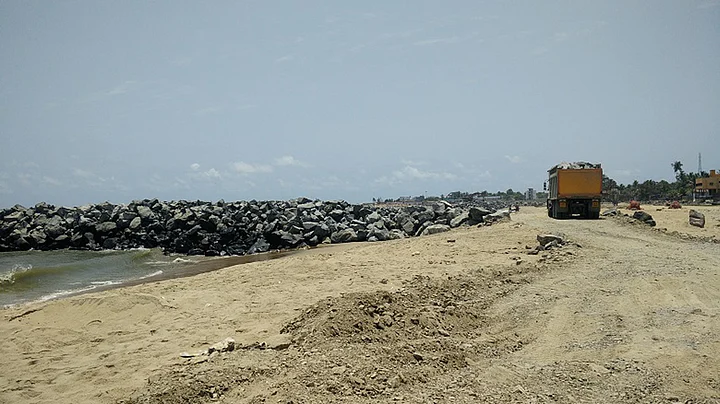Kovalam is a fishing hamlet 30 km south of Chennai, the capital of Tamil Nadu. Initially developed as a port town, Kovalam is famous for its beaches, particularly the natural bay formation of the coast and the sprawling sand dunes.
Over the years, the beach stretches in Kovalam have witnessed an increase in built-up area that includes private housing, resorts and surf schools. An old fort on the beaches of Kovalam has been taken over by Taj Group of Hotels for its private beach resort, the Fishermen’s Cove.
Sudden surge in coastal development, flattening of sand dunes, rising sea levels and an already eroding southern coastline has resulted in widespread beach erosion in Kovalam.
In a bid to tackle the erosion, contractors employed by the Tamil Nadu Fisheries Department are dumping large rocks to construct groynes in the Kovalam seas. Groynes are rigid (wood or concrete) hydraulic structures built from an ocean shore or from a river bank that interrupt water flow and limit the movement of sediment.
Three groynes, approximately 800m long and 3m wide have been erected perpendicular to the coast, less than a kilometer from each other. One groyne has been constructed on the northern side of Taj Group’s beach resort Fishermen’s Cove and one groyne on the southern side. Construction of the third one further south is ongoing.
To facilitate the construction of these groynes, illegal roads have been constructed using bituminous waste and gravel on the beach. The latest road is being built across the Kovalam River Mouth to facilitate the movement of lorries to sites earmarked for more groynes.
CRZ Kept Out of Loop?
According to the Coastal Regulation Zone Notification 2011, prior permission of the Coastal Zone Management Authority is mandatory before undertaking any work in the CRZ areas. The place where construction of these groynes are ongoing fall in the CRZ IV (Water Body) and CRZ I (Intertidal Zone).
Government departments too, are required to follow the same process. However the fisheries department seemed surprised when asked about CRZ Clearances.
Such projects ought to be discussed and looked into in-depth. Clearances are required before work begins. When we spoke to the Tamil Nadu Coastal Zone Management Authority (TNZMA), they admitted that no permission has been sought or given for groynes in Kovalam. The absence of any government official, police personnel or contractor-supervisor at the place of construction further strengthens the suspicion of this being an illegal activity.
Tamil Nadu does not have a single-window clearance department that proactively protects the coast.
The TNZMA does not have a finalized Coastal Zone Management Plan, or a Shoreline Management Plan. In the absence of such crucial plans, it is relevant to ask if the adequate planning including addressing environmental concerns have been addressed for this project.
Why Groynes Are Bad
Construction of groynes in areas where erosion prevails is only a temporary solution. These structures block the natural flow of sand by obstructing the long shore drift, aggravating erosion on the northern side. Apart from accelerating erosion, groynes put tremendous amount of pressure on the water table, making it more susceptible to salt water intrusion.
Studies show that hard structures such as groynes increase the rate of sand recession as compared to natural shoreline recession. This is a bleak projection for Chennai’s beaches as they all fall in the high-risk erosion zone.
It is important to mention that erosion of the coastal stretch of Pondicherry and other areas to it’s north resulted in the construction of groynes that acts as a physical barrier to sand movement close to villages like Kottaikuppam in Kanchipuram District. However, this exercise has proven disastrous for fishing villages further as they have lost precious livelihood spaces to the sea. Does the same fate await the fishing hamlets and beaches on the northern side of Kovalam?
(The writer is a Chennai-based campaigner with the Coastal Resource Centre of The Other Media.)
